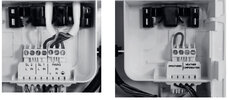I am looking for some help if i may. The house was re plumbed a few months ago and i am now having the electrics completed.
As part of the electrical finals i have asked the electrician to wire the central heating/Hot water system so that i can finally do away with running the boiler for a few hours a day to give me hot water to have a shower.
He is happy to do it but is a new build 1st/2nd fix guy and says the plumber normally deals with it. All he wants is a schematic for him to follow and i am good to go.
I have watched a number of videos as i like to understand what is being done and there are millions of drawings online but none seem to be quite identical to what i have which is strange as its a very common set up.
WB Greenstar System boiler (located in garage)
Megaflow cylinder (located in the loft)
Nest 3rd gen stat & heatlink
1 heating valve feeding rads upstairs
Upstairs temp controlled by Nest
1 heating valve serving UFH downstairs
Downstairs heating controlled by multiple stats connected to the UFH manifold
1 valve serving CHW controlled by nest programmer
I understand that i need an S Plan + set up.
In my head i had the heatlink and wiring center being located in the loft next to the cylinder with a link between that and the boiler.
There are spurs available at the boiler and loft locations for mains power.
Does anyone have a schematic showing the wiring that i can give him to wire to?
Any help is much appreciated.
As part of the electrical finals i have asked the electrician to wire the central heating/Hot water system so that i can finally do away with running the boiler for a few hours a day to give me hot water to have a shower.
He is happy to do it but is a new build 1st/2nd fix guy and says the plumber normally deals with it. All he wants is a schematic for him to follow and i am good to go.
I have watched a number of videos as i like to understand what is being done and there are millions of drawings online but none seem to be quite identical to what i have which is strange as its a very common set up.
WB Greenstar System boiler (located in garage)
Megaflow cylinder (located in the loft)
Nest 3rd gen stat & heatlink
1 heating valve feeding rads upstairs
Upstairs temp controlled by Nest
1 heating valve serving UFH downstairs
Downstairs heating controlled by multiple stats connected to the UFH manifold
1 valve serving CHW controlled by nest programmer
I understand that i need an S Plan + set up.
In my head i had the heatlink and wiring center being located in the loft next to the cylinder with a link between that and the boiler.
There are spurs available at the boiler and loft locations for mains power.
Does anyone have a schematic showing the wiring that i can give him to wire to?
Any help is much appreciated.



